ERP Implementation Challenges and Strategies: A Detailed Report
VerifiedAdded on 2020/03/16
|13
|3285
|62
Report
AI Summary
This report critically examines the challenges associated with Enterprise Resource Planning (ERP) implementation, focusing on knowledge management and change management issues. It explores the potential consequences of these challenges on organizational operations, such as configuration and assimilation knowledge gaps, and resistance to change. The report analyzes the impact of organizational structure, formalization, differentiation, and decentralization on ERP success. It also highlights the importance of effective project management, employee training, and communication in mitigating these challenges. The report recommends strategies to address these issues, including comprehensive change management plans, addressing employee concerns, and ensuring adequate technical skills. The report concludes by emphasizing the need for proactive measures to ensure successful ERP implementation and avoid organizational failure.
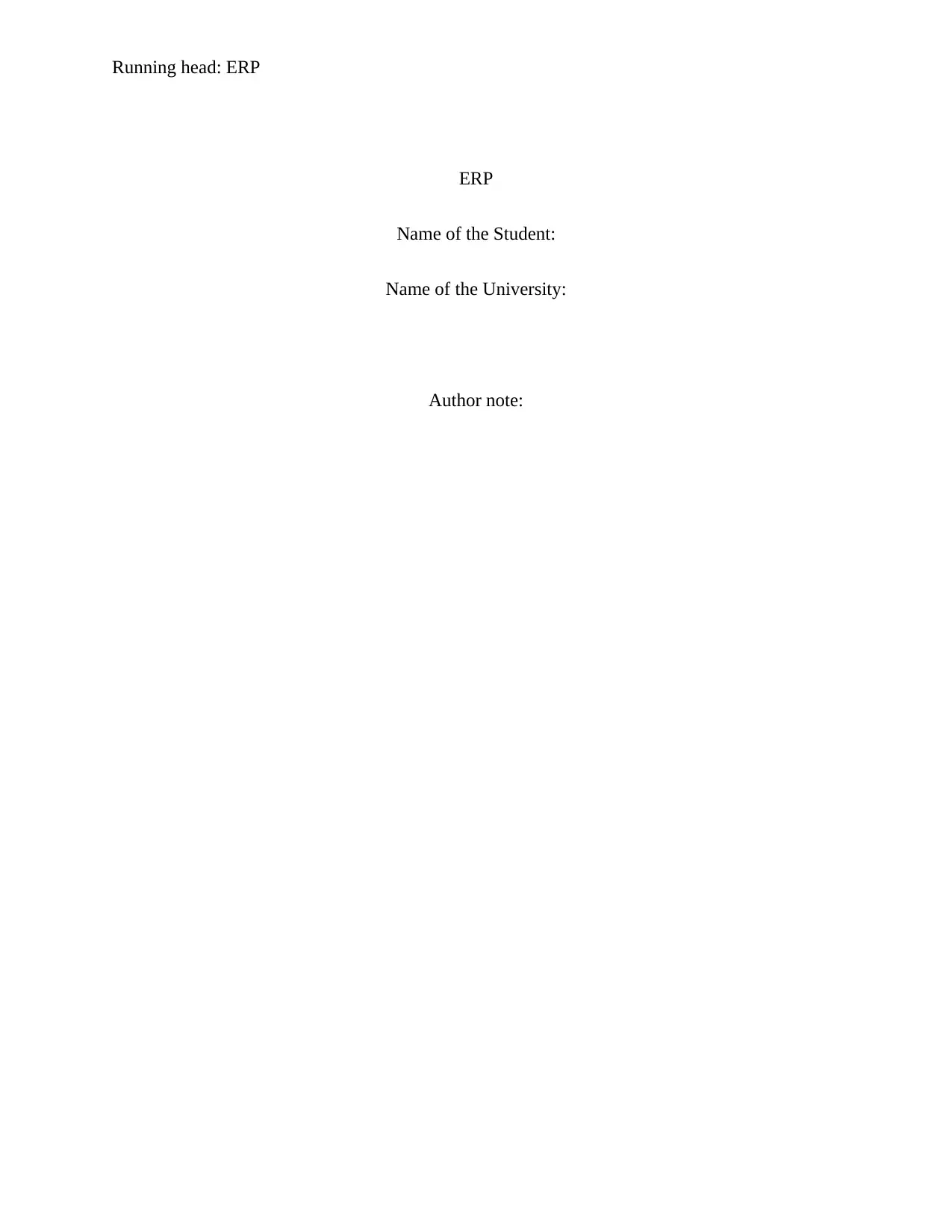
Running head: ERP
ERP
Name of the Student:
Name of the University:
Author note:
ERP
Name of the Student:
Name of the University:
Author note:
Paraphrase This Document
Need a fresh take? Get an instant paraphrase of this document with our AI Paraphraser
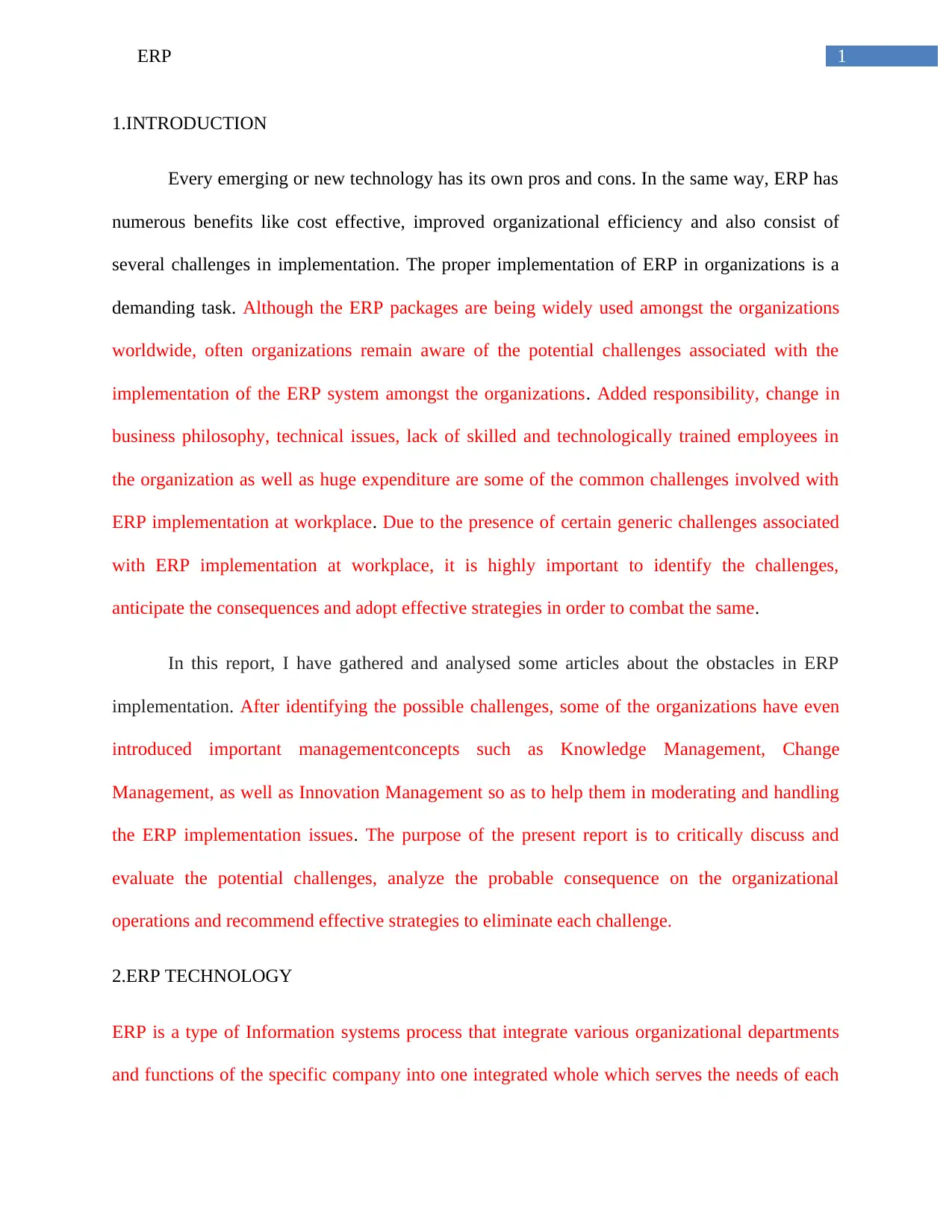
1ERP
1.INTRODUCTION
Every emerging or new technology has its own pros and cons. In the same way, ERP has
numerous benefits like cost effective, improved organizational efficiency and also consist of
several challenges in implementation. The proper implementation of ERP in organizations is a
demanding task. Although the ERP packages are being widely used amongst the organizations
worldwide, often organizations remain aware of the potential challenges associated with the
implementation of the ERP system amongst the organizations. Added responsibility, change in
business philosophy, technical issues, lack of skilled and technologically trained employees in
the organization as well as huge expenditure are some of the common challenges involved with
ERP implementation at workplace. Due to the presence of certain generic challenges associated
with ERP implementation at workplace, it is highly important to identify the challenges,
anticipate the consequences and adopt effective strategies in order to combat the same.
In this report, I have gathered and analysed some articles about the obstacles in ERP
implementation. After identifying the possible challenges, some of the organizations have even
introduced important managementconcepts such as Knowledge Management, Change
Management, as well as Innovation Management so as to help them in moderating and handling
the ERP implementation issues. The purpose of the present report is to critically discuss and
evaluate the potential challenges, analyze the probable consequence on the organizational
operations and recommend effective strategies to eliminate each challenge.
2.ERP TECHNOLOGY
ERP is a type of Information systems process that integrate various organizational departments
and functions of the specific company into one integrated whole which serves the needs of each
1.INTRODUCTION
Every emerging or new technology has its own pros and cons. In the same way, ERP has
numerous benefits like cost effective, improved organizational efficiency and also consist of
several challenges in implementation. The proper implementation of ERP in organizations is a
demanding task. Although the ERP packages are being widely used amongst the organizations
worldwide, often organizations remain aware of the potential challenges associated with the
implementation of the ERP system amongst the organizations. Added responsibility, change in
business philosophy, technical issues, lack of skilled and technologically trained employees in
the organization as well as huge expenditure are some of the common challenges involved with
ERP implementation at workplace. Due to the presence of certain generic challenges associated
with ERP implementation at workplace, it is highly important to identify the challenges,
anticipate the consequences and adopt effective strategies in order to combat the same.
In this report, I have gathered and analysed some articles about the obstacles in ERP
implementation. After identifying the possible challenges, some of the organizations have even
introduced important managementconcepts such as Knowledge Management, Change
Management, as well as Innovation Management so as to help them in moderating and handling
the ERP implementation issues. The purpose of the present report is to critically discuss and
evaluate the potential challenges, analyze the probable consequence on the organizational
operations and recommend effective strategies to eliminate each challenge.
2.ERP TECHNOLOGY
ERP is a type of Information systems process that integrate various organizational departments
and functions of the specific company into one integrated whole which serves the needs of each
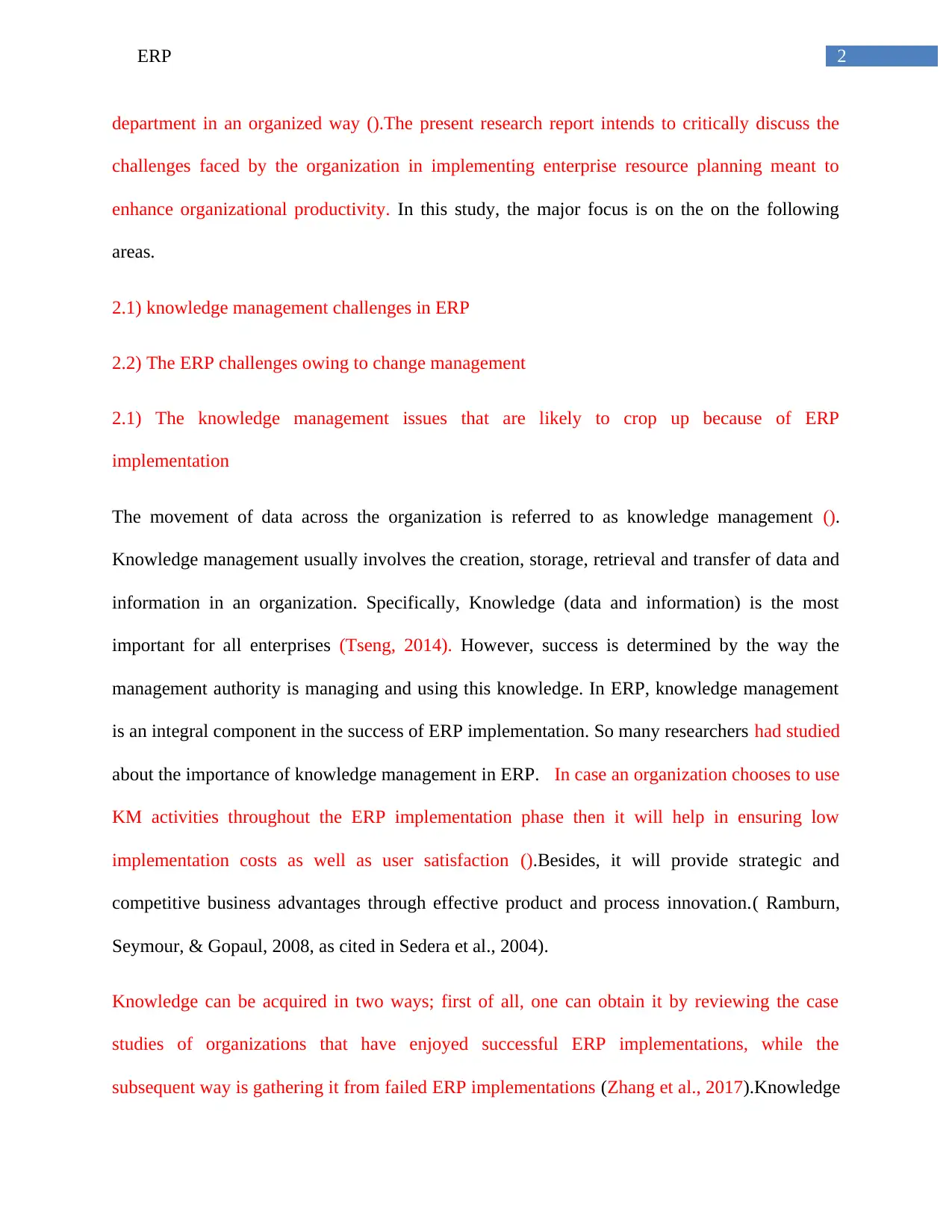
2ERP
department in an organized way ().The present research report intends to critically discuss the
challenges faced by the organization in implementing enterprise resource planning meant to
enhance organizational productivity. In this study, the major focus is on the on the following
areas.
2.1) knowledge management challenges in ERP
2.2) The ERP challenges owing to change management
2.1) The knowledge management issues that are likely to crop up because of ERP
implementation
The movement of data across the organization is referred to as knowledge management ().
Knowledge management usually involves the creation, storage, retrieval and transfer of data and
information in an organization. Specifically, Knowledge (data and information) is the most
important for all enterprises (Tseng, 2014). However, success is determined by the way the
management authority is managing and using this knowledge. In ERP, knowledge management
is an integral component in the success of ERP implementation. So many researchers had studied
about the importance of knowledge management in ERP. In case an organization chooses to use
KM activities throughout the ERP implementation phase then it will help in ensuring low
implementation costs as well as user satisfaction ().Besides, it will provide strategic and
competitive business advantages through effective product and process innovation.( Ramburn,
Seymour, & Gopaul, 2008, as cited in Sedera et al., 2004).
Knowledge can be acquired in two ways; first of all, one can obtain it by reviewing the case
studies of organizations that have enjoyed successful ERP implementations, while the
subsequent way is gathering it from failed ERP implementations (Zhang et al., 2017).Knowledge
department in an organized way ().The present research report intends to critically discuss the
challenges faced by the organization in implementing enterprise resource planning meant to
enhance organizational productivity. In this study, the major focus is on the on the following
areas.
2.1) knowledge management challenges in ERP
2.2) The ERP challenges owing to change management
2.1) The knowledge management issues that are likely to crop up because of ERP
implementation
The movement of data across the organization is referred to as knowledge management ().
Knowledge management usually involves the creation, storage, retrieval and transfer of data and
information in an organization. Specifically, Knowledge (data and information) is the most
important for all enterprises (Tseng, 2014). However, success is determined by the way the
management authority is managing and using this knowledge. In ERP, knowledge management
is an integral component in the success of ERP implementation. So many researchers had studied
about the importance of knowledge management in ERP. In case an organization chooses to use
KM activities throughout the ERP implementation phase then it will help in ensuring low
implementation costs as well as user satisfaction ().Besides, it will provide strategic and
competitive business advantages through effective product and process innovation.( Ramburn,
Seymour, & Gopaul, 2008, as cited in Sedera et al., 2004).
Knowledge can be acquired in two ways; first of all, one can obtain it by reviewing the case
studies of organizations that have enjoyed successful ERP implementations, while the
subsequent way is gathering it from failed ERP implementations (Zhang et al., 2017).Knowledge
⊘ This is a preview!⊘
Do you want full access?
Subscribe today to unlock all pages.

Trusted by 1+ million students worldwide
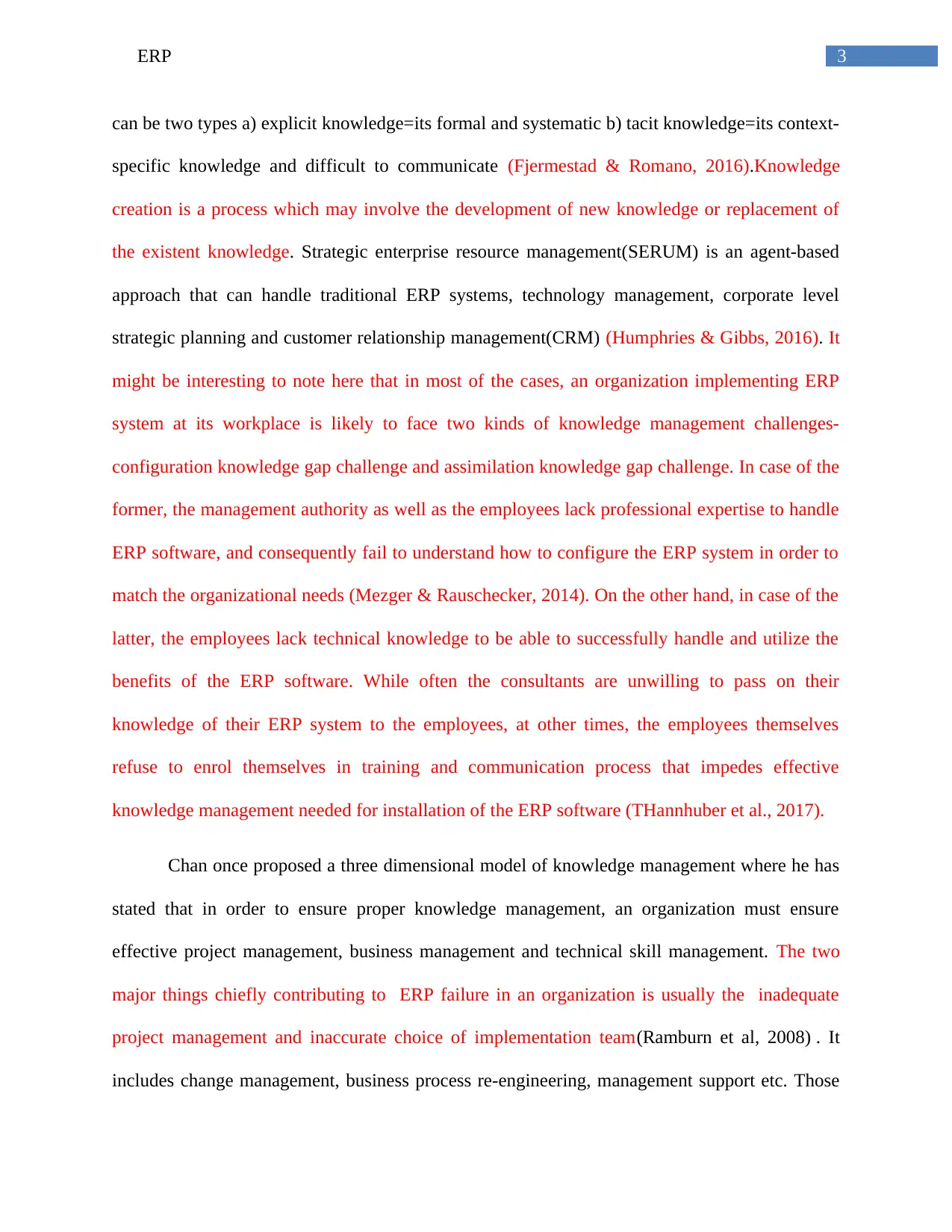
3ERP
can be two types a) explicit knowledge=its formal and systematic b) tacit knowledge=its context-
specific knowledge and difficult to communicate (Fjermestad & Romano, 2016).Knowledge
creation is a process which may involve the development of new knowledge or replacement of
the existent knowledge. Strategic enterprise resource management(SERUM) is an agent-based
approach that can handle traditional ERP systems, technology management, corporate level
strategic planning and customer relationship management(CRM) (Humphries & Gibbs, 2016). It
might be interesting to note here that in most of the cases, an organization implementing ERP
system at its workplace is likely to face two kinds of knowledge management challenges-
configuration knowledge gap challenge and assimilation knowledge gap challenge. In case of the
former, the management authority as well as the employees lack professional expertise to handle
ERP software, and consequently fail to understand how to configure the ERP system in order to
match the organizational needs (Mezger & Rauschecker, 2014). On the other hand, in case of the
latter, the employees lack technical knowledge to be able to successfully handle and utilize the
benefits of the ERP software. While often the consultants are unwilling to pass on their
knowledge of their ERP system to the employees, at other times, the employees themselves
refuse to enrol themselves in training and communication process that impedes effective
knowledge management needed for installation of the ERP software (THannhuber et al., 2017).
Chan once proposed a three dimensional model of knowledge management where he has
stated that in order to ensure proper knowledge management, an organization must ensure
effective project management, business management and technical skill management. The two
major things chiefly contributing to ERP failure in an organization is usually the inadequate
project management and inaccurate choice of implementation team(Ramburn et al, 2008) . It
includes change management, business process re-engineering, management support etc. Those
can be two types a) explicit knowledge=its formal and systematic b) tacit knowledge=its context-
specific knowledge and difficult to communicate (Fjermestad & Romano, 2016).Knowledge
creation is a process which may involve the development of new knowledge or replacement of
the existent knowledge. Strategic enterprise resource management(SERUM) is an agent-based
approach that can handle traditional ERP systems, technology management, corporate level
strategic planning and customer relationship management(CRM) (Humphries & Gibbs, 2016). It
might be interesting to note here that in most of the cases, an organization implementing ERP
system at its workplace is likely to face two kinds of knowledge management challenges-
configuration knowledge gap challenge and assimilation knowledge gap challenge. In case of the
former, the management authority as well as the employees lack professional expertise to handle
ERP software, and consequently fail to understand how to configure the ERP system in order to
match the organizational needs (Mezger & Rauschecker, 2014). On the other hand, in case of the
latter, the employees lack technical knowledge to be able to successfully handle and utilize the
benefits of the ERP software. While often the consultants are unwilling to pass on their
knowledge of their ERP system to the employees, at other times, the employees themselves
refuse to enrol themselves in training and communication process that impedes effective
knowledge management needed for installation of the ERP software (THannhuber et al., 2017).
Chan once proposed a three dimensional model of knowledge management where he has
stated that in order to ensure proper knowledge management, an organization must ensure
effective project management, business management and technical skill management. The two
major things chiefly contributing to ERP failure in an organization is usually the inadequate
project management and inaccurate choice of implementation team(Ramburn et al, 2008) . It
includes change management, business process re-engineering, management support etc. Those
Paraphrase This Document
Need a fresh take? Get an instant paraphrase of this document with our AI Paraphraser
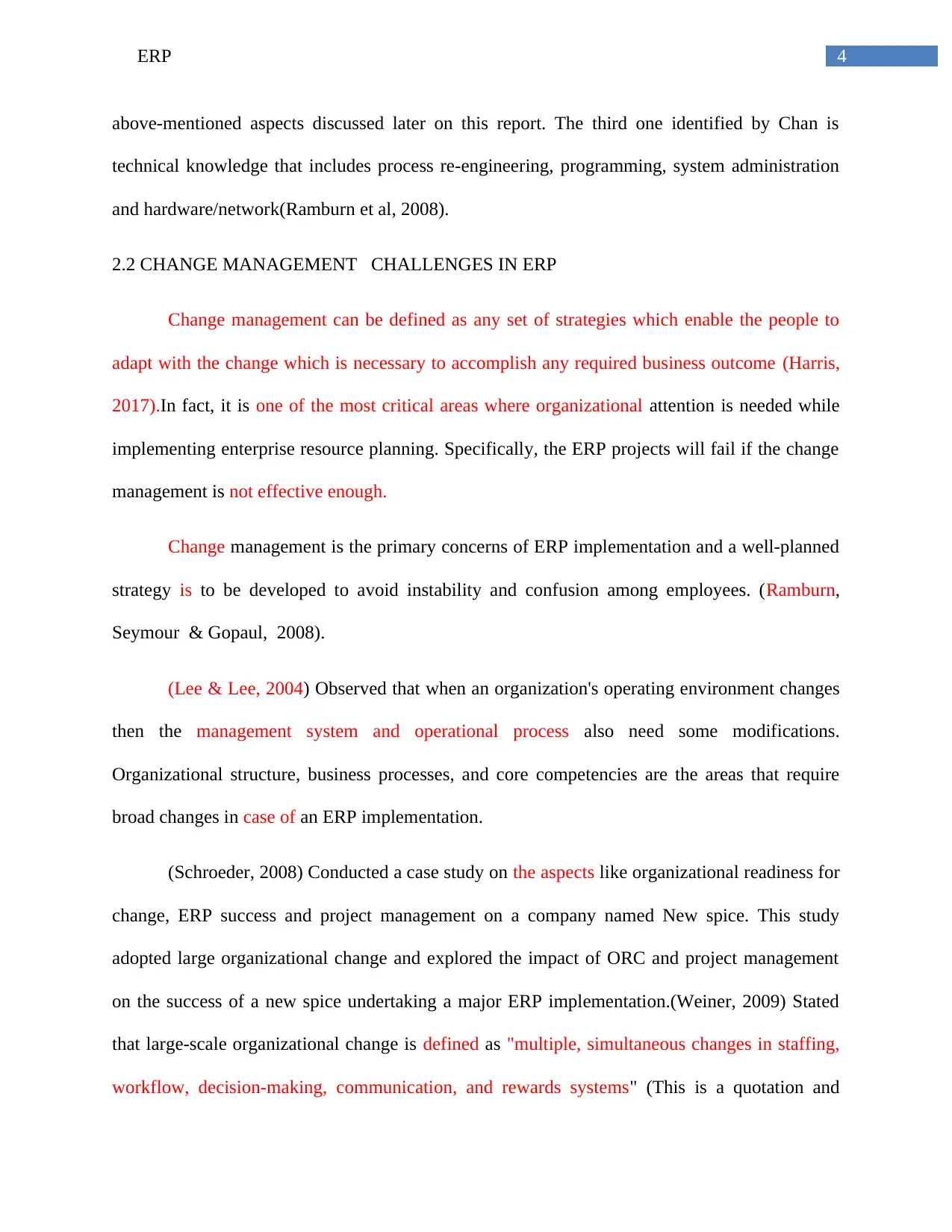
4ERP
above-mentioned aspects discussed later on this report. The third one identified by Chan is
technical knowledge that includes process re-engineering, programming, system administration
and hardware/network(Ramburn et al, 2008).
2.2 CHANGE MANAGEMENT CHALLENGES IN ERP
Change management can be defined as any set of strategies which enable the people to
adapt with the change which is necessary to accomplish any required business outcome (Harris,
2017).In fact, it is one of the most critical areas where organizational attention is needed while
implementing enterprise resource planning. Specifically, the ERP projects will fail if the change
management is not effective enough.
Change management is the primary concerns of ERP implementation and a well-planned
strategy is to be developed to avoid instability and confusion among employees. (Ramburn,
Seymour & Gopaul, 2008).
(Lee & Lee, 2004) Observed that when an organization's operating environment changes
then the management system and operational process also need some modifications.
Organizational structure, business processes, and core competencies are the areas that require
broad changes in case of an ERP implementation.
(Schroeder, 2008) Conducted a case study on the aspects like organizational readiness for
change, ERP success and project management on a company named New spice. This study
adopted large organizational change and explored the impact of ORC and project management
on the success of a new spice undertaking a major ERP implementation.(Weiner, 2009) Stated
that large-scale organizational change is defined as "multiple, simultaneous changes in staffing,
workflow, decision-making, communication, and rewards systems" (This is a quotation and
above-mentioned aspects discussed later on this report. The third one identified by Chan is
technical knowledge that includes process re-engineering, programming, system administration
and hardware/network(Ramburn et al, 2008).
2.2 CHANGE MANAGEMENT CHALLENGES IN ERP
Change management can be defined as any set of strategies which enable the people to
adapt with the change which is necessary to accomplish any required business outcome (Harris,
2017).In fact, it is one of the most critical areas where organizational attention is needed while
implementing enterprise resource planning. Specifically, the ERP projects will fail if the change
management is not effective enough.
Change management is the primary concerns of ERP implementation and a well-planned
strategy is to be developed to avoid instability and confusion among employees. (Ramburn,
Seymour & Gopaul, 2008).
(Lee & Lee, 2004) Observed that when an organization's operating environment changes
then the management system and operational process also need some modifications.
Organizational structure, business processes, and core competencies are the areas that require
broad changes in case of an ERP implementation.
(Schroeder, 2008) Conducted a case study on the aspects like organizational readiness for
change, ERP success and project management on a company named New spice. This study
adopted large organizational change and explored the impact of ORC and project management
on the success of a new spice undertaking a major ERP implementation.(Weiner, 2009) Stated
that large-scale organizational change is defined as "multiple, simultaneous changes in staffing,
workflow, decision-making, communication, and rewards systems" (This is a quotation and
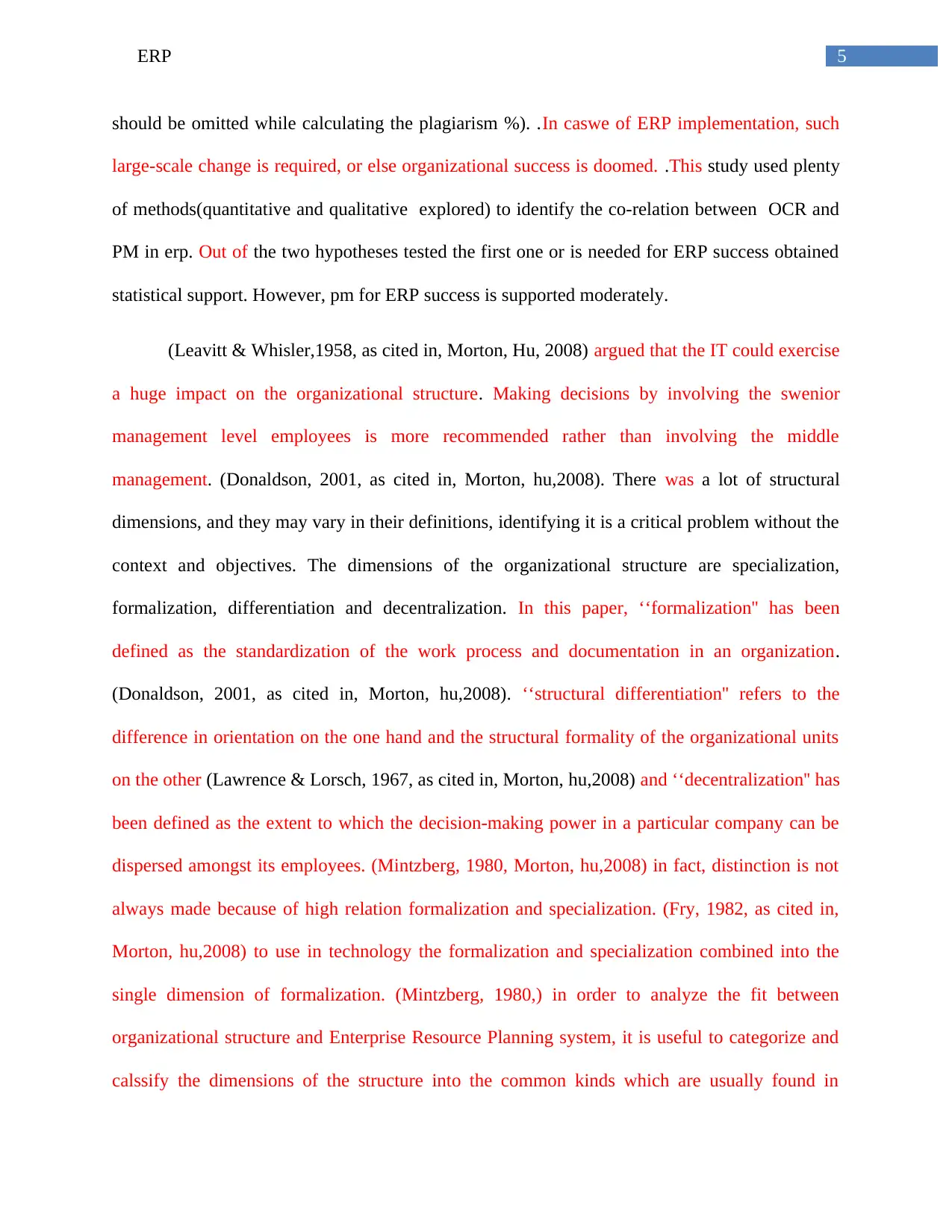
5ERP
should be omitted while calculating the plagiarism %). .In caswe of ERP implementation, such
large-scale change is required, or else organizational success is doomed. .This study used plenty
of methods(quantitative and qualitative explored) to identify the co-relation between OCR and
PM in erp. Out of the two hypotheses tested the first one or is needed for ERP success obtained
statistical support. However, pm for ERP success is supported moderately.
(Leavitt & Whisler,1958, as cited in, Morton, Hu, 2008) argued that the IT could exercise
a huge impact on the organizational structure. Making decisions by involving the swenior
management level employees is more recommended rather than involving the middle
management. (Donaldson, 2001, as cited in, Morton, hu,2008). There was a lot of structural
dimensions, and they may vary in their definitions, identifying it is a critical problem without the
context and objectives. The dimensions of the organizational structure are specialization,
formalization, differentiation and decentralization. In this paper, ‘‘formalization'' has been
defined as the standardization of the work process and documentation in an organization.
(Donaldson, 2001, as cited in, Morton, hu,2008). ‘‘structural differentiation'' refers to the
difference in orientation on the one hand and the structural formality of the organizational units
on the other (Lawrence & Lorsch, 1967, as cited in, Morton, hu,2008) and ‘‘decentralization'' has
been defined as the extent to which the decision-making power in a particular company can be
dispersed amongst its employees. (Mintzberg, 1980, Morton, hu,2008) in fact, distinction is not
always made because of high relation formalization and specialization. (Fry, 1982, as cited in,
Morton, hu,2008) to use in technology the formalization and specialization combined into the
single dimension of formalization. (Mintzberg, 1980,) in order to analyze the fit between
organizational structure and Enterprise Resource Planning system, it is useful to categorize and
calssify the dimensions of the structure into the common kinds which are usually found in
should be omitted while calculating the plagiarism %). .In caswe of ERP implementation, such
large-scale change is required, or else organizational success is doomed. .This study used plenty
of methods(quantitative and qualitative explored) to identify the co-relation between OCR and
PM in erp. Out of the two hypotheses tested the first one or is needed for ERP success obtained
statistical support. However, pm for ERP success is supported moderately.
(Leavitt & Whisler,1958, as cited in, Morton, Hu, 2008) argued that the IT could exercise
a huge impact on the organizational structure. Making decisions by involving the swenior
management level employees is more recommended rather than involving the middle
management. (Donaldson, 2001, as cited in, Morton, hu,2008). There was a lot of structural
dimensions, and they may vary in their definitions, identifying it is a critical problem without the
context and objectives. The dimensions of the organizational structure are specialization,
formalization, differentiation and decentralization. In this paper, ‘‘formalization'' has been
defined as the standardization of the work process and documentation in an organization.
(Donaldson, 2001, as cited in, Morton, hu,2008). ‘‘structural differentiation'' refers to the
difference in orientation on the one hand and the structural formality of the organizational units
on the other (Lawrence & Lorsch, 1967, as cited in, Morton, hu,2008) and ‘‘decentralization'' has
been defined as the extent to which the decision-making power in a particular company can be
dispersed amongst its employees. (Mintzberg, 1980, Morton, hu,2008) in fact, distinction is not
always made because of high relation formalization and specialization. (Fry, 1982, as cited in,
Morton, hu,2008) to use in technology the formalization and specialization combined into the
single dimension of formalization. (Mintzberg, 1980,) in order to analyze the fit between
organizational structure and Enterprise Resource Planning system, it is useful to categorize and
calssify the dimensions of the structure into the common kinds which are usually found in
⊘ This is a preview!⊘
Do you want full access?
Subscribe today to unlock all pages.

Trusted by 1+ million students worldwide
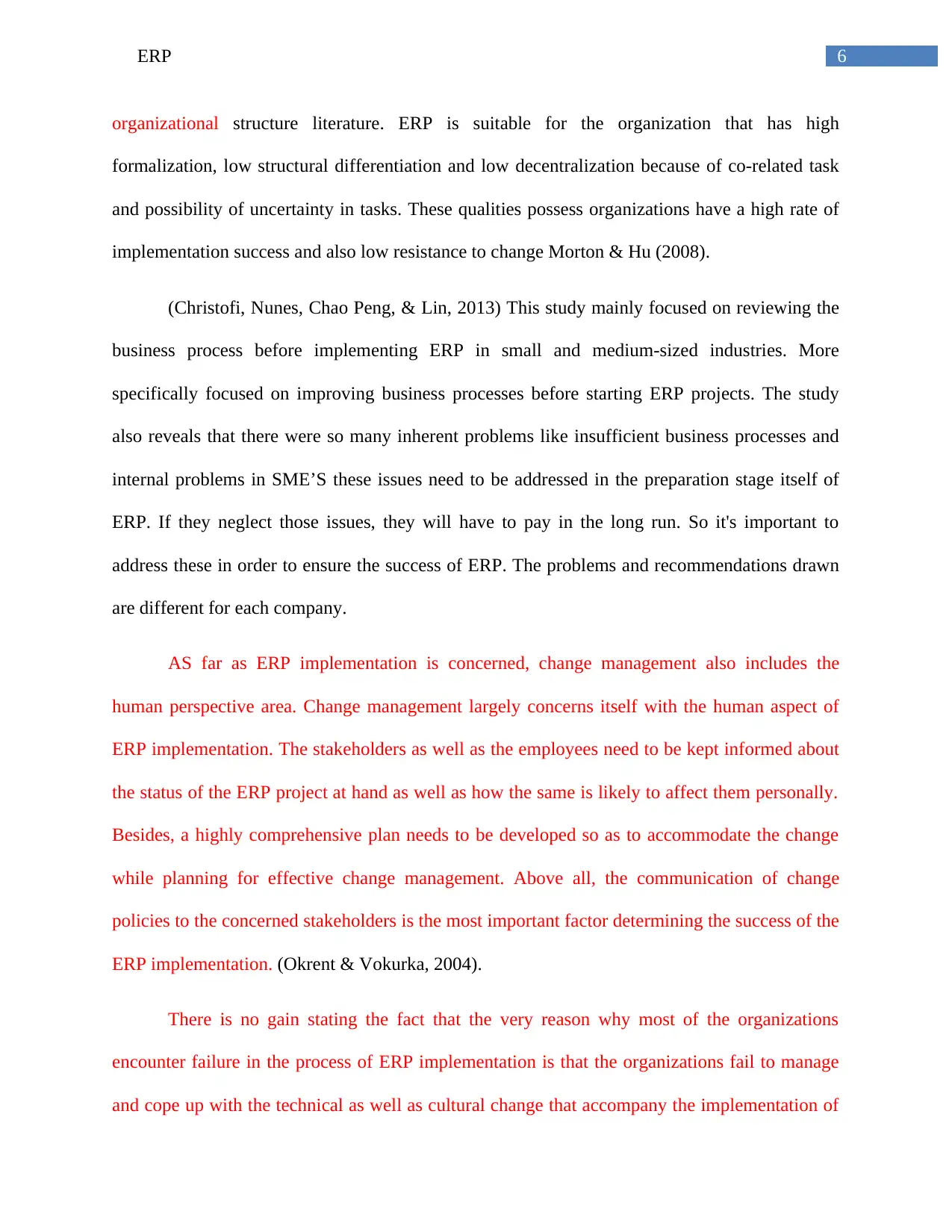
6ERP
organizational structure literature. ERP is suitable for the organization that has high
formalization, low structural differentiation and low decentralization because of co-related task
and possibility of uncertainty in tasks. These qualities possess organizations have a high rate of
implementation success and also low resistance to change Morton & Hu (2008).
(Christofi, Nunes, Chao Peng, & Lin, 2013) This study mainly focused on reviewing the
business process before implementing ERP in small and medium-sized industries. More
specifically focused on improving business processes before starting ERP projects. The study
also reveals that there were so many inherent problems like insufficient business processes and
internal problems in SME’S these issues need to be addressed in the preparation stage itself of
ERP. If they neglect those issues, they will have to pay in the long run. So it's important to
address these in order to ensure the success of ERP. The problems and recommendations drawn
are different for each company.
AS far as ERP implementation is concerned, change management also includes the
human perspective area. Change management largely concerns itself with the human aspect of
ERP implementation. The stakeholders as well as the employees need to be kept informed about
the status of the ERP project at hand as well as how the same is likely to affect them personally.
Besides, a highly comprehensive plan needs to be developed so as to accommodate the change
while planning for effective change management. Above all, the communication of change
policies to the concerned stakeholders is the most important factor determining the success of the
ERP implementation. (Okrent & Vokurka, 2004).
There is no gain stating the fact that the very reason why most of the organizations
encounter failure in the process of ERP implementation is that the organizations fail to manage
and cope up with the technical as well as cultural change that accompany the implementation of
organizational structure literature. ERP is suitable for the organization that has high
formalization, low structural differentiation and low decentralization because of co-related task
and possibility of uncertainty in tasks. These qualities possess organizations have a high rate of
implementation success and also low resistance to change Morton & Hu (2008).
(Christofi, Nunes, Chao Peng, & Lin, 2013) This study mainly focused on reviewing the
business process before implementing ERP in small and medium-sized industries. More
specifically focused on improving business processes before starting ERP projects. The study
also reveals that there were so many inherent problems like insufficient business processes and
internal problems in SME’S these issues need to be addressed in the preparation stage itself of
ERP. If they neglect those issues, they will have to pay in the long run. So it's important to
address these in order to ensure the success of ERP. The problems and recommendations drawn
are different for each company.
AS far as ERP implementation is concerned, change management also includes the
human perspective area. Change management largely concerns itself with the human aspect of
ERP implementation. The stakeholders as well as the employees need to be kept informed about
the status of the ERP project at hand as well as how the same is likely to affect them personally.
Besides, a highly comprehensive plan needs to be developed so as to accommodate the change
while planning for effective change management. Above all, the communication of change
policies to the concerned stakeholders is the most important factor determining the success of the
ERP implementation. (Okrent & Vokurka, 2004).
There is no gain stating the fact that the very reason why most of the organizations
encounter failure in the process of ERP implementation is that the organizations fail to manage
and cope up with the technical as well as cultural change that accompany the implementation of
Paraphrase This Document
Need a fresh take? Get an instant paraphrase of this document with our AI Paraphraser
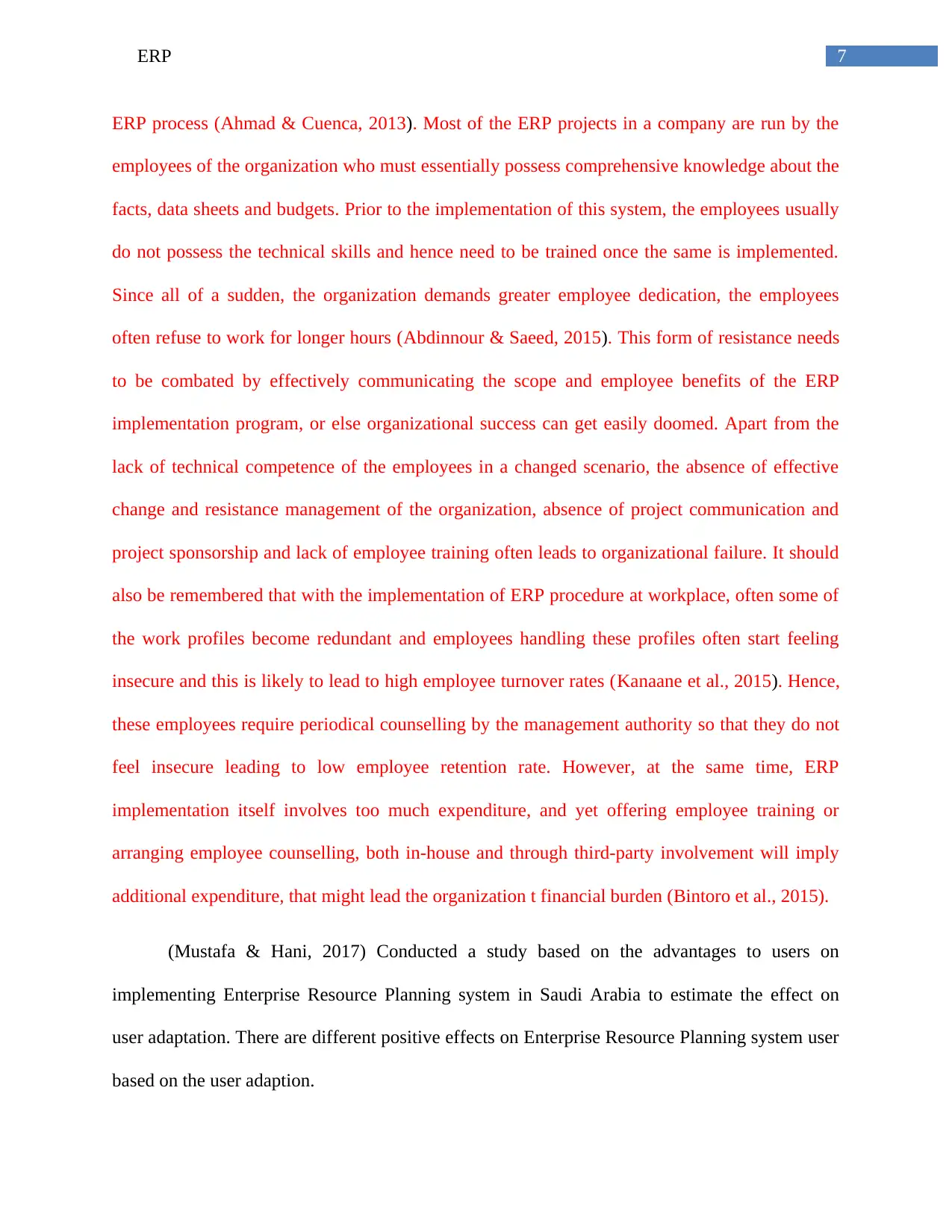
7ERP
ERP process (Ahmad & Cuenca, 2013). Most of the ERP projects in a company are run by the
employees of the organization who must essentially possess comprehensive knowledge about the
facts, data sheets and budgets. Prior to the implementation of this system, the employees usually
do not possess the technical skills and hence need to be trained once the same is implemented.
Since all of a sudden, the organization demands greater employee dedication, the employees
often refuse to work for longer hours (Abdinnour & Saeed, 2015). This form of resistance needs
to be combated by effectively communicating the scope and employee benefits of the ERP
implementation program, or else organizational success can get easily doomed. Apart from the
lack of technical competence of the employees in a changed scenario, the absence of effective
change and resistance management of the organization, absence of project communication and
project sponsorship and lack of employee training often leads to organizational failure. It should
also be remembered that with the implementation of ERP procedure at workplace, often some of
the work profiles become redundant and employees handling these profiles often start feeling
insecure and this is likely to lead to high employee turnover rates (Kanaane et al., 2015). Hence,
these employees require periodical counselling by the management authority so that they do not
feel insecure leading to low employee retention rate. However, at the same time, ERP
implementation itself involves too much expenditure, and yet offering employee training or
arranging employee counselling, both in-house and through third-party involvement will imply
additional expenditure, that might lead the organization t financial burden (Bintoro et al., 2015).
(Mustafa & Hani, 2017) Conducted a study based on the advantages to users on
implementing Enterprise Resource Planning system in Saudi Arabia to estimate the effect on
user adaptation. There are different positive effects on Enterprise Resource Planning system user
based on the user adaption.
ERP process (Ahmad & Cuenca, 2013). Most of the ERP projects in a company are run by the
employees of the organization who must essentially possess comprehensive knowledge about the
facts, data sheets and budgets. Prior to the implementation of this system, the employees usually
do not possess the technical skills and hence need to be trained once the same is implemented.
Since all of a sudden, the organization demands greater employee dedication, the employees
often refuse to work for longer hours (Abdinnour & Saeed, 2015). This form of resistance needs
to be combated by effectively communicating the scope and employee benefits of the ERP
implementation program, or else organizational success can get easily doomed. Apart from the
lack of technical competence of the employees in a changed scenario, the absence of effective
change and resistance management of the organization, absence of project communication and
project sponsorship and lack of employee training often leads to organizational failure. It should
also be remembered that with the implementation of ERP procedure at workplace, often some of
the work profiles become redundant and employees handling these profiles often start feeling
insecure and this is likely to lead to high employee turnover rates (Kanaane et al., 2015). Hence,
these employees require periodical counselling by the management authority so that they do not
feel insecure leading to low employee retention rate. However, at the same time, ERP
implementation itself involves too much expenditure, and yet offering employee training or
arranging employee counselling, both in-house and through third-party involvement will imply
additional expenditure, that might lead the organization t financial burden (Bintoro et al., 2015).
(Mustafa & Hani, 2017) Conducted a study based on the advantages to users on
implementing Enterprise Resource Planning system in Saudi Arabia to estimate the effect on
user adaptation. There are different positive effects on Enterprise Resource Planning system user
based on the user adaption.
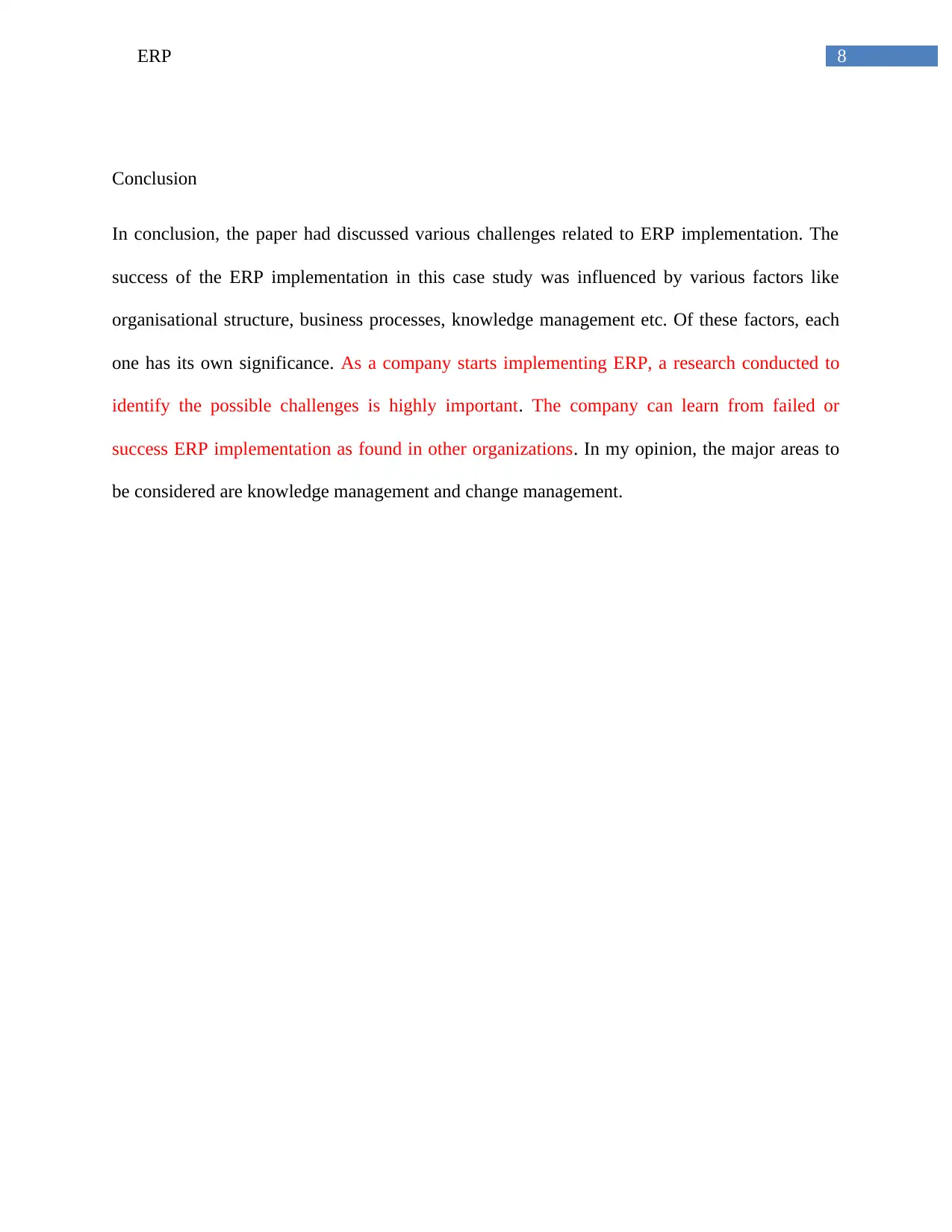
8ERP
Conclusion
In conclusion, the paper had discussed various challenges related to ERP implementation. The
success of the ERP implementation in this case study was influenced by various factors like
organisational structure, business processes, knowledge management etc. Of these factors, each
one has its own significance. As a company starts implementing ERP, a research conducted to
identify the possible challenges is highly important. The company can learn from failed or
success ERP implementation as found in other organizations. In my opinion, the major areas to
be considered are knowledge management and change management.
Conclusion
In conclusion, the paper had discussed various challenges related to ERP implementation. The
success of the ERP implementation in this case study was influenced by various factors like
organisational structure, business processes, knowledge management etc. Of these factors, each
one has its own significance. As a company starts implementing ERP, a research conducted to
identify the possible challenges is highly important. The company can learn from failed or
success ERP implementation as found in other organizations. In my opinion, the major areas to
be considered are knowledge management and change management.
⊘ This is a preview!⊘
Do you want full access?
Subscribe today to unlock all pages.

Trusted by 1+ million students worldwide
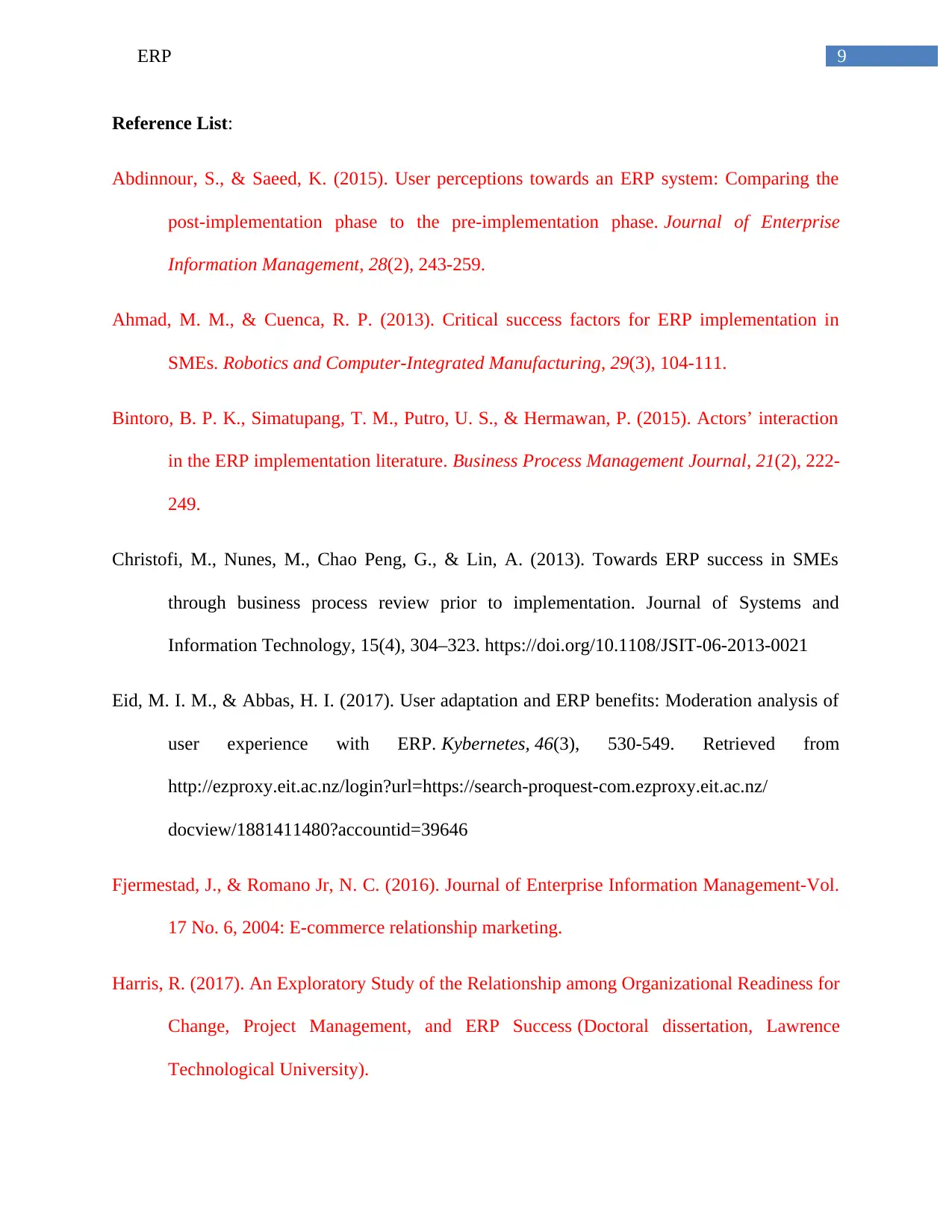
9ERP
Reference List:
Abdinnour, S., & Saeed, K. (2015). User perceptions towards an ERP system: Comparing the
post-implementation phase to the pre-implementation phase. Journal of Enterprise
Information Management, 28(2), 243-259.
Ahmad, M. M., & Cuenca, R. P. (2013). Critical success factors for ERP implementation in
SMEs. Robotics and Computer-Integrated Manufacturing, 29(3), 104-111.
Bintoro, B. P. K., Simatupang, T. M., Putro, U. S., & Hermawan, P. (2015). Actors’ interaction
in the ERP implementation literature. Business Process Management Journal, 21(2), 222-
249.
Christofi, M., Nunes, M., Chao Peng, G., & Lin, A. (2013). Towards ERP success in SMEs
through business process review prior to implementation. Journal of Systems and
Information Technology, 15(4), 304–323. https://doi.org/10.1108/JSIT-06-2013-0021
Eid, M. I. M., & Abbas, H. I. (2017). User adaptation and ERP benefits: Moderation analysis of
user experience with ERP. Kybernetes, 46(3), 530-549. Retrieved from
http://ezproxy.eit.ac.nz/login?url=https://search-proquest-com.ezproxy.eit.ac.nz/
docview/1881411480?accountid=39646
Fjermestad, J., & Romano Jr, N. C. (2016). Journal of Enterprise Information Management-Vol.
17 No. 6, 2004: E-commerce relationship marketing.
Harris, R. (2017). An Exploratory Study of the Relationship among Organizational Readiness for
Change, Project Management, and ERP Success (Doctoral dissertation, Lawrence
Technological University).
Reference List:
Abdinnour, S., & Saeed, K. (2015). User perceptions towards an ERP system: Comparing the
post-implementation phase to the pre-implementation phase. Journal of Enterprise
Information Management, 28(2), 243-259.
Ahmad, M. M., & Cuenca, R. P. (2013). Critical success factors for ERP implementation in
SMEs. Robotics and Computer-Integrated Manufacturing, 29(3), 104-111.
Bintoro, B. P. K., Simatupang, T. M., Putro, U. S., & Hermawan, P. (2015). Actors’ interaction
in the ERP implementation literature. Business Process Management Journal, 21(2), 222-
249.
Christofi, M., Nunes, M., Chao Peng, G., & Lin, A. (2013). Towards ERP success in SMEs
through business process review prior to implementation. Journal of Systems and
Information Technology, 15(4), 304–323. https://doi.org/10.1108/JSIT-06-2013-0021
Eid, M. I. M., & Abbas, H. I. (2017). User adaptation and ERP benefits: Moderation analysis of
user experience with ERP. Kybernetes, 46(3), 530-549. Retrieved from
http://ezproxy.eit.ac.nz/login?url=https://search-proquest-com.ezproxy.eit.ac.nz/
docview/1881411480?accountid=39646
Fjermestad, J., & Romano Jr, N. C. (2016). Journal of Enterprise Information Management-Vol.
17 No. 6, 2004: E-commerce relationship marketing.
Harris, R. (2017). An Exploratory Study of the Relationship among Organizational Readiness for
Change, Project Management, and ERP Success (Doctoral dissertation, Lawrence
Technological University).
Paraphrase This Document
Need a fresh take? Get an instant paraphrase of this document with our AI Paraphraser
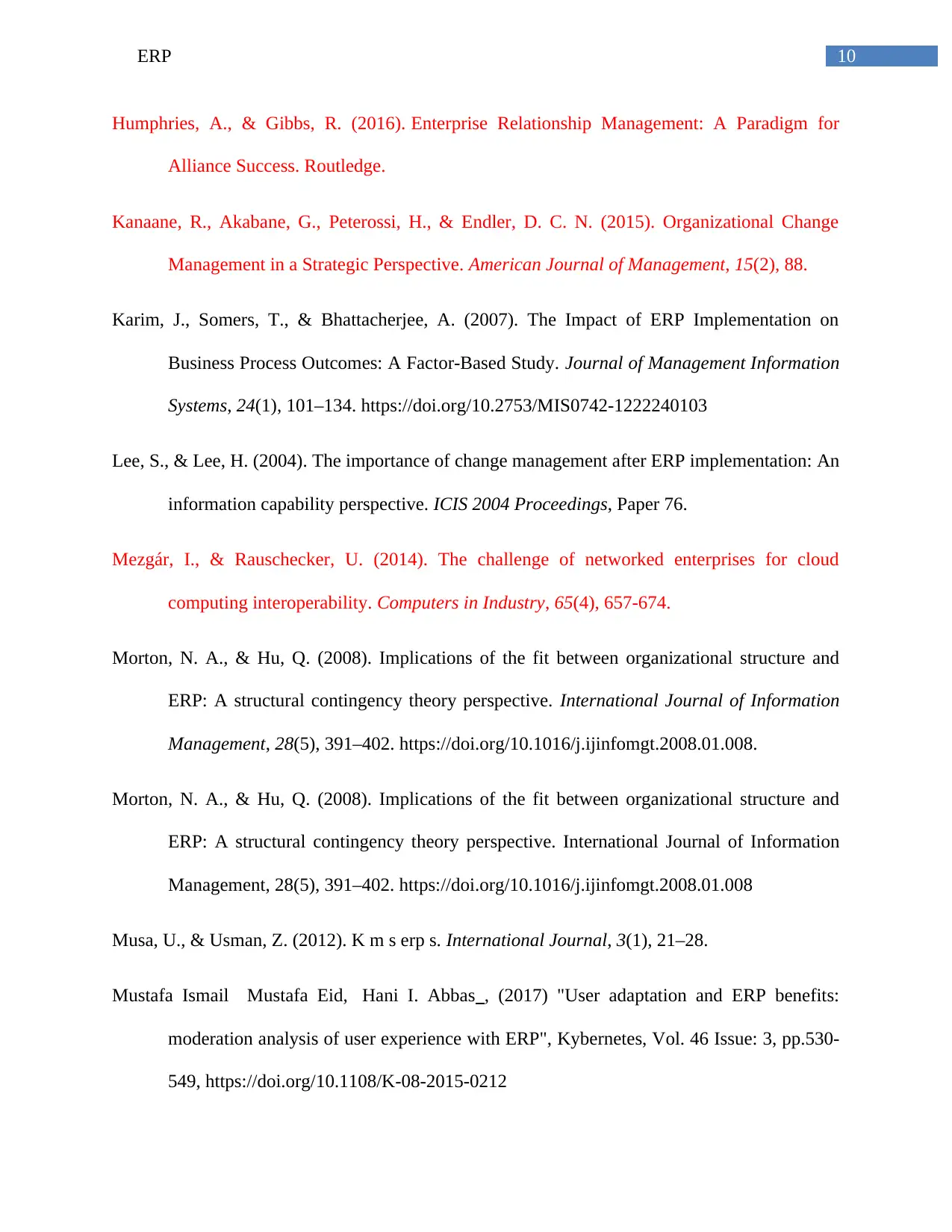
10ERP
Humphries, A., & Gibbs, R. (2016). Enterprise Relationship Management: A Paradigm for
Alliance Success. Routledge.
Kanaane, R., Akabane, G., Peterossi, H., & Endler, D. C. N. (2015). Organizational Change
Management in a Strategic Perspective. American Journal of Management, 15(2), 88.
Karim, J., Somers, T., & Bhattacherjee, A. (2007). The Impact of ERP Implementation on
Business Process Outcomes: A Factor-Based Study. Journal of Management Information
Systems, 24(1), 101–134. https://doi.org/10.2753/MIS0742-1222240103
Lee, S., & Lee, H. (2004). The importance of change management after ERP implementation: An
information capability perspective. ICIS 2004 Proceedings, Paper 76.
Mezgár, I., & Rauschecker, U. (2014). The challenge of networked enterprises for cloud
computing interoperability. Computers in Industry, 65(4), 657-674.
Morton, N. A., & Hu, Q. (2008). Implications of the fit between organizational structure and
ERP: A structural contingency theory perspective. International Journal of Information
Management, 28(5), 391–402. https://doi.org/10.1016/j.ijinfomgt.2008.01.008.
Morton, N. A., & Hu, Q. (2008). Implications of the fit between organizational structure and
ERP: A structural contingency theory perspective. International Journal of Information
Management, 28(5), 391–402. https://doi.org/10.1016/j.ijinfomgt.2008.01.008
Musa, U., & Usman, Z. (2012). K m s erp s. International Journal, 3(1), 21–28.
Mustafa Ismail Mustafa Eid, Hani I. Abbas , (2017) "User adaptation and ERP benefits:
moderation analysis of user experience with ERP", Kybernetes, Vol. 46 Issue: 3, pp.530-
549, https://doi.org/10.1108/K-08-2015-0212
Humphries, A., & Gibbs, R. (2016). Enterprise Relationship Management: A Paradigm for
Alliance Success. Routledge.
Kanaane, R., Akabane, G., Peterossi, H., & Endler, D. C. N. (2015). Organizational Change
Management in a Strategic Perspective. American Journal of Management, 15(2), 88.
Karim, J., Somers, T., & Bhattacherjee, A. (2007). The Impact of ERP Implementation on
Business Process Outcomes: A Factor-Based Study. Journal of Management Information
Systems, 24(1), 101–134. https://doi.org/10.2753/MIS0742-1222240103
Lee, S., & Lee, H. (2004). The importance of change management after ERP implementation: An
information capability perspective. ICIS 2004 Proceedings, Paper 76.
Mezgár, I., & Rauschecker, U. (2014). The challenge of networked enterprises for cloud
computing interoperability. Computers in Industry, 65(4), 657-674.
Morton, N. A., & Hu, Q. (2008). Implications of the fit between organizational structure and
ERP: A structural contingency theory perspective. International Journal of Information
Management, 28(5), 391–402. https://doi.org/10.1016/j.ijinfomgt.2008.01.008.
Morton, N. A., & Hu, Q. (2008). Implications of the fit between organizational structure and
ERP: A structural contingency theory perspective. International Journal of Information
Management, 28(5), 391–402. https://doi.org/10.1016/j.ijinfomgt.2008.01.008
Musa, U., & Usman, Z. (2012). K m s erp s. International Journal, 3(1), 21–28.
Mustafa Ismail Mustafa Eid, Hani I. Abbas , (2017) "User adaptation and ERP benefits:
moderation analysis of user experience with ERP", Kybernetes, Vol. 46 Issue: 3, pp.530-
549, https://doi.org/10.1108/K-08-2015-0212

11ERP
Ramburn, A., Seymour, L., & Gopaul, A. (2008). Learning From a Failed ERP implementation :
The Case of a Large South African Organization. European Conference on Information
Management & Evaluation, 215–223.
Schroeder, K. E. (2008). Lawrence Technological University. Business, 162.
Thannhuber, M. J., Bruntsch, A., & Tseng, M. M. (2017). Knowledge management: managing
organizational intelligence and knowledge in autopoietic process management systems–
ten years into industrial application. Procedia CIRP, 63, 384-389.
Tseng, S. M. (2014). The impact of knowledge management capabilities and supplier
relationship management on corporate performance. International Journal of Production
Economics, 154, 39-47.
Weiner, B. J. (2009). A theory of organizational readiness for change. Implementation Science,
4. doi:10.1186/1748-5908-4-67
Zhang, D., Zhang, D., Li, S., Li, S., Zheng, D., & Zheng, D. (2017). Knowledge search and open
innovation performance in an emerging market: Moderating effects of government-
enterprise relationship and market focus. Management Decision, 55(4), 634-647.
Ramburn, A., Seymour, L., & Gopaul, A. (2008). Learning From a Failed ERP implementation :
The Case of a Large South African Organization. European Conference on Information
Management & Evaluation, 215–223.
Schroeder, K. E. (2008). Lawrence Technological University. Business, 162.
Thannhuber, M. J., Bruntsch, A., & Tseng, M. M. (2017). Knowledge management: managing
organizational intelligence and knowledge in autopoietic process management systems–
ten years into industrial application. Procedia CIRP, 63, 384-389.
Tseng, S. M. (2014). The impact of knowledge management capabilities and supplier
relationship management on corporate performance. International Journal of Production
Economics, 154, 39-47.
Weiner, B. J. (2009). A theory of organizational readiness for change. Implementation Science,
4. doi:10.1186/1748-5908-4-67
Zhang, D., Zhang, D., Li, S., Li, S., Zheng, D., & Zheng, D. (2017). Knowledge search and open
innovation performance in an emerging market: Moderating effects of government-
enterprise relationship and market focus. Management Decision, 55(4), 634-647.
⊘ This is a preview!⊘
Do you want full access?
Subscribe today to unlock all pages.

Trusted by 1+ million students worldwide
1 out of 13
Related Documents
Your All-in-One AI-Powered Toolkit for Academic Success.
+13062052269
info@desklib.com
Available 24*7 on WhatsApp / Email
![[object Object]](/_next/static/media/star-bottom.7253800d.svg)
Unlock your academic potential
Copyright © 2020–2025 A2Z Services. All Rights Reserved. Developed and managed by ZUCOL.





